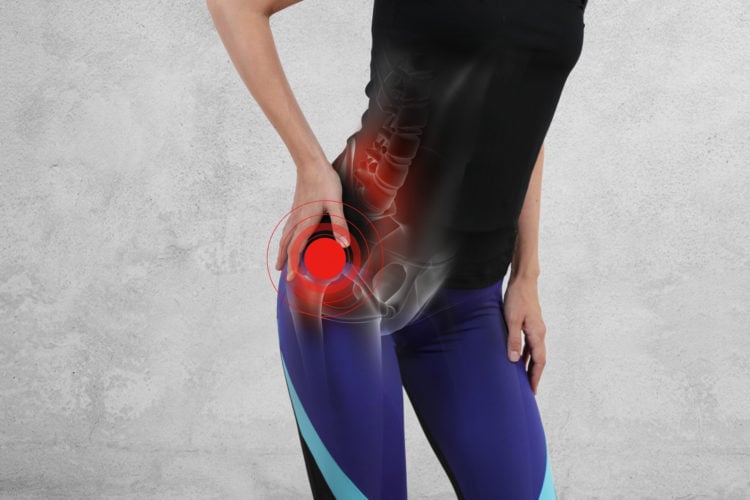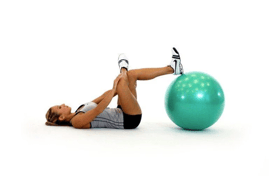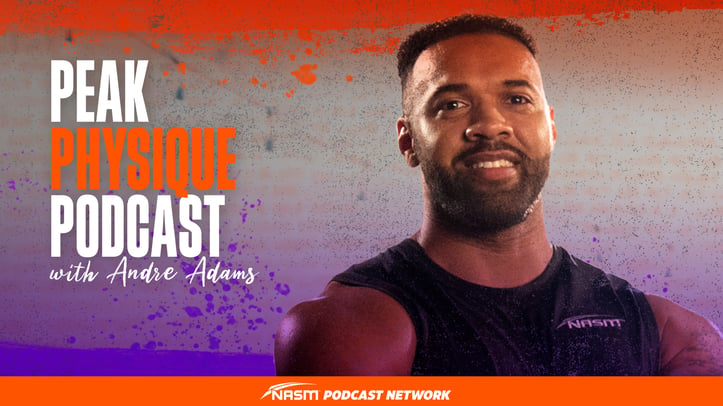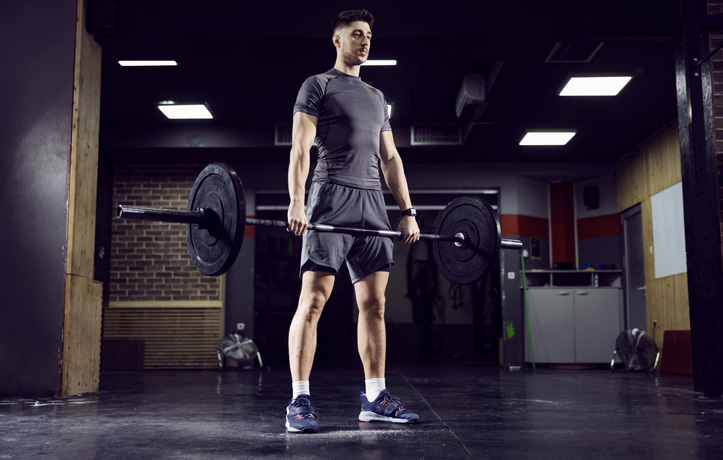Discomfort from too much sitting? Inactive glutes? Buttock and leg pain? Though small in size, the piriformis could have a big impact on keeping the human movement system moving smoothly. Addressing an overactive piriformis may be part of the solution.
Within this article, you will find some valuable stretches to relieve piriformis syndrome.
For further validation on the effectiveness of stretching from a corrective exercise perspective, enroll in the Stretching and Flexibility Coach course by NASM.
What is the Piriformis?
The piriformis is a tiny muscle that originates on the anterior surface of the sacrum, travels through the greater sciatic foramen, and attaches to the greater trochanter of the femur (1,2). It accelerates hip external rotation, abduction, and extension.
What is Piriformis Syndrome?
Piriformis syndrome has traditionally been described as a referred neural pain in the posterior hip and leg caused by hypertrophy or spasm of the piriformis. The pain is caused by pressure applied to the sciatic nerve by the piriformis due to the passage of the nerve through or under the muscle (2).
Pain associated with this problem often mimics the signs and symptoms of lumbar nerve root compression or sciatica in the buttock and posterior leg. The client will often report sciatica-type symptoms and experience tenderness in the piriformis fossa. Pain when sitting is common, as is pain with hip flexion, adduction, and internal rotation.
Signs and Symptoms of Piriformis Syndrome
The signs and symptoms of piriformis syndrome are:
- Pain in the buttock
- Pain down the back of the hamstring, or posterior thigh
- Pain when sitting
- Pain when walking up stairs or inclines
- decreased range of motion of the hip joint
While the signs and symptoms of the syndrome may be similar to other lumbo-pelvic pathology, the cause of piriformis syndrome remains relatively undefined as to reasons for development of spasm or hypertrophy of the muscle.
See "Is The Piriformis Tight? Really?" for an additional perspective on symptoms, causes, and solutions of Piriformis Syndrome.
It is interesting to note that a description of the syndrome is found in most medical texts, yet the criteria for diagnosing piriformis syndrome and pathophysiology still remains a controversial issue (3,4).
However, the reason why the piriformis is hypertrophied or in spasm is often described as "undefined and confusing." If the practitioner considers the principles of the kinetic chain and dysfunction of its linked components, it is not difficult to hypothesize why the piriformis may become involved in an impingement of the sciatic nerve. If the client has chronic tightness of the hip flexor, the gluteus maximus will become reciprocally inhibited (1).
This is significant because of the functional responsibility of the glute to decelerate medial femoral rotation during heel strike or functional movements. Since the piriformis is a primary external rotator of the femur, it becomes synergistically dominant in controlling the femur.
This type of dominant function has the potential for causing the spasm, hypertrophy, or tightness described in most texts. The external hip rotators have also been noted as being the least stretched muscles of the lower body (5).
Piriformis Syndrome Treatment and Therapy
If a client complains of pain in their buttocks, hip rotators, or the lumbo-pelvic complex in general, the health and fitness professional should first instruct the client to visit their medical professional. If a client has been released from therapy or their doctor and the pain persists, an effective corrective exercise strategy for correcting this type of dysfunction would be to first release the hip flexor through appropriate integrated flexibility techniques, then implement reeducation of the gluteus maximus through isolated strength training.
Finally, recondition the lumbo-pelvic hip complex through integrated functional movements in the appropriate range of motion, plane of motion, and speed, specific to the needs of the client.
Piriformis Stretches To Try
- Foam Roll Piriformis
- Foam Roll Quads
- Foam Roll IT Band
- Static Stretch Piriformis
- Static Stretch Biceps Femoris
- Static Stretch Hip Flexors
- Leg Slides
- Floor Bridge
- Lateral Tube Walking
- Ball Squats
SMR Piriformis
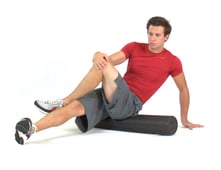 Sit on top of a foam roll with the foam roll placed directly on the back of the hip. Cross one leg over the other, placing your foot onto the opposite knee. Slowly roll the back of the hip, applying prolonged pressure on tender spots for roughly 30 seconds.
Sit on top of a foam roll with the foam roll placed directly on the back of the hip. Cross one leg over the other, placing your foot onto the opposite knee. Slowly roll the back of the hip, applying prolonged pressure on tender spots for roughly 30 seconds.
SMR Quads
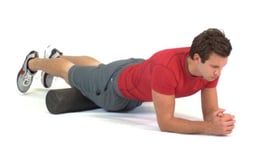 Lie on your stomach with a foam roll placed under the front of your thigh. Support your upper body on your forearms. Slowly roll the front of your thigh, applying prolonged pressure on tender spots for roughly 30 seconds.
Lie on your stomach with a foam roll placed under the front of your thigh. Support your upper body on your forearms. Slowly roll the front of your thigh, applying prolonged pressure on tender spots for roughly 30 seconds.
SMR IT BAND
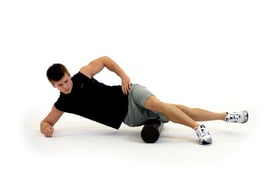 For the IT band, lie on your side with the foam roll placed under your hip. Cross your top leg over the leg on the foam roll and place your foot on the floor. The leg on the foam roll should be raised off the floor and remain that way during the exercise. Slowly roll from the hip to the knee, rolling along the outer thigh, slightly in front of the hip and knee, applying prolonged pressure on tender spots for roughly 30 seconds.
For the IT band, lie on your side with the foam roll placed under your hip. Cross your top leg over the leg on the foam roll and place your foot on the floor. The leg on the foam roll should be raised off the floor and remain that way during the exercise. Slowly roll from the hip to the knee, rolling along the outer thigh, slightly in front of the hip and knee, applying prolonged pressure on tender spots for roughly 30 seconds.
Static Stretch: Piriformis
Lie on your back with one foot placed on top of a stability ball and the other foot crossed over your knee. Pull the ball toward your body with your heel. Press the crossed knee away from you until a stretch is felt in the back of your hip. Hold for 30 seconds.
Static Stretch: Biceps Femoris
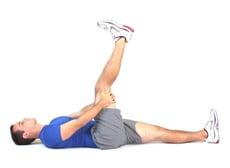 Lie on your back and bend one hip and knee 90-degrees. Leave the other leg extended on the floor. Hold your bent leg and extend at your knee, moving your lower leg straight into the air until a stretch is felt in the back of the upper leg. Hold for 30 seconds.
Lie on your back and bend one hip and knee 90-degrees. Leave the other leg extended on the floor. Hold your bent leg and extend at your knee, moving your lower leg straight into the air until a stretch is felt in the back of the upper leg. Hold for 30 seconds.
Static Stretch: Hip Flexors
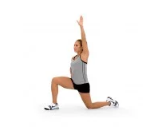 Kneel on your back leg, bending your front leg 90-degrees. Contract your glutes and shift your body forward. Raise the arm that is on the same side as the knee that is on the ground, stretching to the opposite side until a stretch is felt in the front of your pelvis. Rotate backwards and hold for 30-seconds.
Kneel on your back leg, bending your front leg 90-degrees. Contract your glutes and shift your body forward. Raise the arm that is on the same side as the knee that is on the ground, stretching to the opposite side until a stretch is felt in the front of your pelvis. Rotate backwards and hold for 30-seconds.
Leg Slides
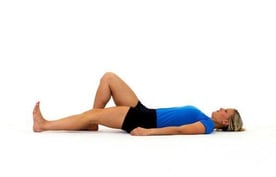
Begin by lying on your back with your knees bent and your feet flat on the floor. Breathe normally as you gently draw-in your navel towards your spine. Hold the contraction and relax as you slowly extend one leg until it is completely flat against the ground. Remember to keep your navel pulled in and be careful not to move your spine. Slowly return your leg to the starting position and repeat with the opposite leg.
Floor Bridge
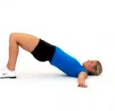 Lie on your back with your knees bent and place your feet flat on the ground, shoulder-width apart. Draw-in your navel and contract your glutes. Slowly push through your heels and lift your pelvis off the floor until your knees, hips and shoulders are in-line. Hold the top position for a few seconds and then slowly lower your pelvis back down to the floor.
Lie on your back with your knees bent and place your feet flat on the ground, shoulder-width apart. Draw-in your navel and contract your glutes. Slowly push through your heels and lift your pelvis off the floor until your knees, hips and shoulders are in-line. Hold the top position for a few seconds and then slowly lower your pelvis back down to the floor.
See the exercise library page on floor bridges for more.
Lateral Tube Walking
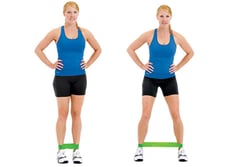 Stand with feet placed hip-width apart, knees slightly bent. Place a piece of tubing around your ankles. Keeping your feet straight, take small steps to one side. After the recommended number of steps, repeat the exercise to the opposite side.
Stand with feet placed hip-width apart, knees slightly bent. Place a piece of tubing around your ankles. Keeping your feet straight, take small steps to one side. After the recommended number of steps, repeat the exercise to the opposite side.
Ball Squats
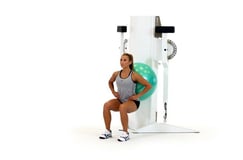 Stand with your feet pointed straight ahead and placed shoulder-width apart. Rest your low back against a stability ball that is placed on a wall. Keep your feet under or slightly in front of your knees. Slowly squat, bending your knees and keeping your feet straight. Keep your chest up, contract your glutes and press through your heels as you return to the starting position.
Stand with your feet pointed straight ahead and placed shoulder-width apart. Rest your low back against a stability ball that is placed on a wall. Keep your feet under or slightly in front of your knees. Slowly squat, bending your knees and keeping your feet straight. Keep your chest up, contract your glutes and press through your heels as you return to the starting position.
Conclusion
If you are interested in learning more about how to best utilize corrective exercise to alleviate inactive piriformis muscles and streamline your client’s movement, look to become a Corrective Exercise Specialist.
For a 4-phase breakdown of the entire corrective exercise process, our Corrective Exercise Continuum is a great reference point.
And our blog post on whether or not you should foam roll the lower back will help guide your SMR programming.
References
- Clark MA, Lucett SC, Sutton BG. (2014). NASM Essentials of Corrective Exercise Training 1st Edition Revised. Burlington, MA: Jones and Bartlett Learning.
- Neumann DA. (2010). Kinesiology of the Musculoskeletal System, Foundations for Rehabilitation 2nd Edition. St. Louis, MO: Mosby Elsevier.
- Halpin RJ, Ganju A. (2009) Piriformis syndrome: a real pain in the buttock? Neurosurgery. Oct;65(4 Suppl):A197-202.
- Hopayian K, Song F, Riera R, Sambandan S. (2010).The clinical features of the piriformis syndrome: a systematic review. European Spine Journal. Dec;19(12): 2095–2109.
- Nelson AG, Kokkonen JJ. (2007). Stretching Anatomy. Champaign, IL: Human Kinetics.

